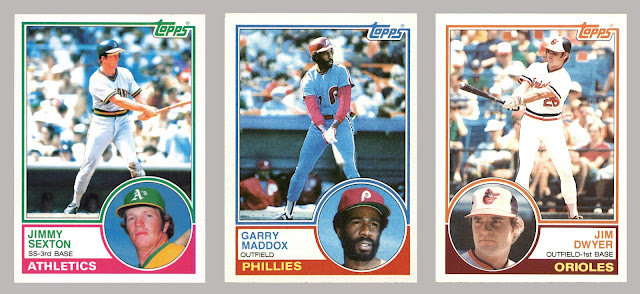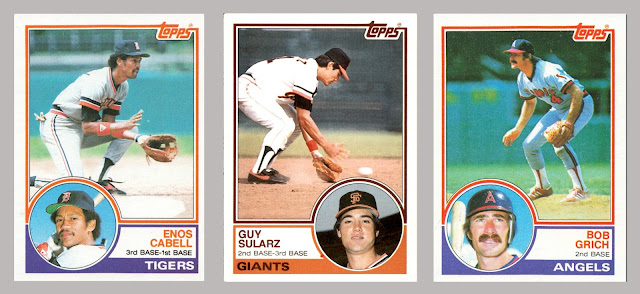When
I shared my completed 1984 Topps baseball set here on
the blog a couple of years ago, I mentioned that it was the very first set of cards I remember
opening packs of and eagerly collecting.
However, the first set of cards I have any memories of at all might be this one.
There's something about that circle graphic in the bottom corner and the contrasting lines of color surrounding it. They stir up some very early memories. In fact, even 40 years later, I still have this niggling notion that I had a few little stacks of 1983 Topps baseball cards (and 1982 Topps football?) in a shoebox back then—my very first stacks of cards ever. I also have a notion that somehow my mom or dad stashed that shoebox in their bedroom closet, up through a little hatchway in the ceiling that provided access to the interior of the roof. I was very young in 1983, and we moved out of that house just a few years later, so that mysterious box became an afterthought rather quickly. But I wonder if it actually ever was in that little crawl space. Maybe it still is.
Regardless, I never
replaced those [unverified] '83 Topps cards at any point during my childhood collecting days. And that means for a long while, I didn't have many cards
from this set at all in my collection.
So I decided it was time to right that wrong.
Because looking back, it was such a fun era for young card collectors. Baseball card designs were bright and kid-friendly. This Week in Baseball was must-watch TV, giving us glimpses of the biggest stars from around the league. And other shows, like The Baseball Bunch, taught us about the fundamentals of the game.
You know what else taught us about the fundamentals of the game?
The 1983 Topps baseball set, that's what! And I think it does it better than most sets of the decade.
Here's what I mean:
Are you up at bat with a runner on first base? First thing you've got to do is loosen up and gain your focus with a couple of practice swings.
Now you're ready. But forget about swinging for the fences all the time. It's 1983. Just slap that ball on the ground, through the big hole on the right side of the infield, and advance the runner to second base. If a hit-and-run play is on, he'll make it to third. You're looking at textbook form up there from Larry Herndon, Ellis Valentine, and Pete Rose.
As for good defense? 1983 Topps had you covered. Enos Cabell and Guy Sularz both show solid technique, staying low and fielding the ball in front of them,
with the right hand ready to trap that ball in the glove. And on the right, look at four-time Gold Glover Bobby Grich on his toes, ready to move in any direction for those hard-hit grounders and line drives.
Topps also reminded us that even though catching a pop-up isn't the most glamorous thing in baseball, every out is important. Every. out.
You know what else is important? Pitching. Look at the balance exhibited by these pitchers during their wind-ups. Work on that technique, young pitchers out there. And trust the fielders behind you.
But hey, for all of the small-ball and fundamentals, Topps also included images that showed hitters taking big cuts, of course.
There were some power pitchers, too, lookin' mean.
Speaking of mean, check out Mike Armstrong on the left. He's looking mean in the main photo and even meaner in the headshot! As for a couple of other photos I found interesting, there's legend Carl Yastrzemski in the middle, giving his fielders some practice, while George Brett on the right demonstrates how players celebrated a home run back then. Simple handshake. Amen.
And we can't forget about the three big rookies: Tony Gwynn, Wade Boggs, and Ryne Sandberg. Add in Willie McGee and Frank Viola, and I think only 1985 Topps competes with them for best rookie group of the decade. (Roger Clemens, Kirby Puckett, Mark McGwire, Dwight Gooden, Eric Davis, Orel Hershiser.)
Now let's talk about the design.
Topps hadn't put a photo insert on the front of their cards since 1963. The new generation of card-collecting kids must have really gotten a kick out of it. Aside from that feature, I do like the way the two-toned borders separate the image on top from the text on the bottom.
As for the color combinations, they're interesting, if not a little abstract. I like the light blue and purple on the Royals cards, for instance. The green and magenta for the A's is a trip, for sure. The Mets received a somewhat disappointing blue and red, while The Indians were given a wacky purple and orange.
Overall, we get lots of fun '80s colors. (Plus some holdover oranges and yellows from the late-70s.)
It's a really solid look—so much so that Topps
would borrow from it just a year or so later for their 1984-85 hockey set!
Now here's a card back
Black text on a light orange background. That ranks pretty high on the legibility meter. If there was room underneath the stats, like on Lloyd Moseby's card, Topps added some of the player's highlights from the previous season. There are no cartoons, which is usually a minus with me, but this time I don't mind it quite as much. I like how the hitter silhouette at top left and pitcher silhouette at bottom right help anchor everything.
Back to the set now. Subsets, to be more specific.
The Super Veterans subset was a whopping 35 cards deep, and featured players who'd been in the league for at least 10 years or so. (Gaylord Perry was the super-est Super Vet, with 24 years of service!)
Card backs include some milestone dates, seasonal bests, and highlights for the player featured on the front. Each Super Veteran card was numbered so it would appear right after the player's base card in the set, which is fine. However, I kind of wish Topps would have run the 35 cards consecutively. It might have been cool to see 4 straight pages of these guys in a binder.
Team Leaders cards were done well, featuring the team's batting average and ERA leader on the front, and a team checklist on the back.
The League Leader cards in this set could have been better. It's a pretty small 8-card subset, toward the end of the binder. The overall design is a little plain.
Like a few other Topps sets of the 1980s, the record breakers were in the lead-off spot. (The 1983 set had six record breaker cards in total.) Players selected for the 1982 All-Star Game received a separate all-star card. I like the big, bold star design in the corner. As for the manager
cards, they were cool, because they listed the manager's playing stats on the
back (if they were MLB players) as well as their managerial stats.
Topps put out some bright checklists throughout the decade, but this set must have some of the brightest ones.
And finally, a winning line-up game piece, one per wax pack.
So that's 1983 Topps baseball. I'm very happy to have completed this well-designed, well-regarded set. The cards are already in a binder, and I'm going to have to remember to take it off the shelf and flip through the pages every so often—maybe before softball games—to remind me of the fundamentals.
So where does the 1983 Topps set rank among all the sets of the decade for you? Do you have any favorite cards from the set?
Share in the comment section, and thanks for reading!


























